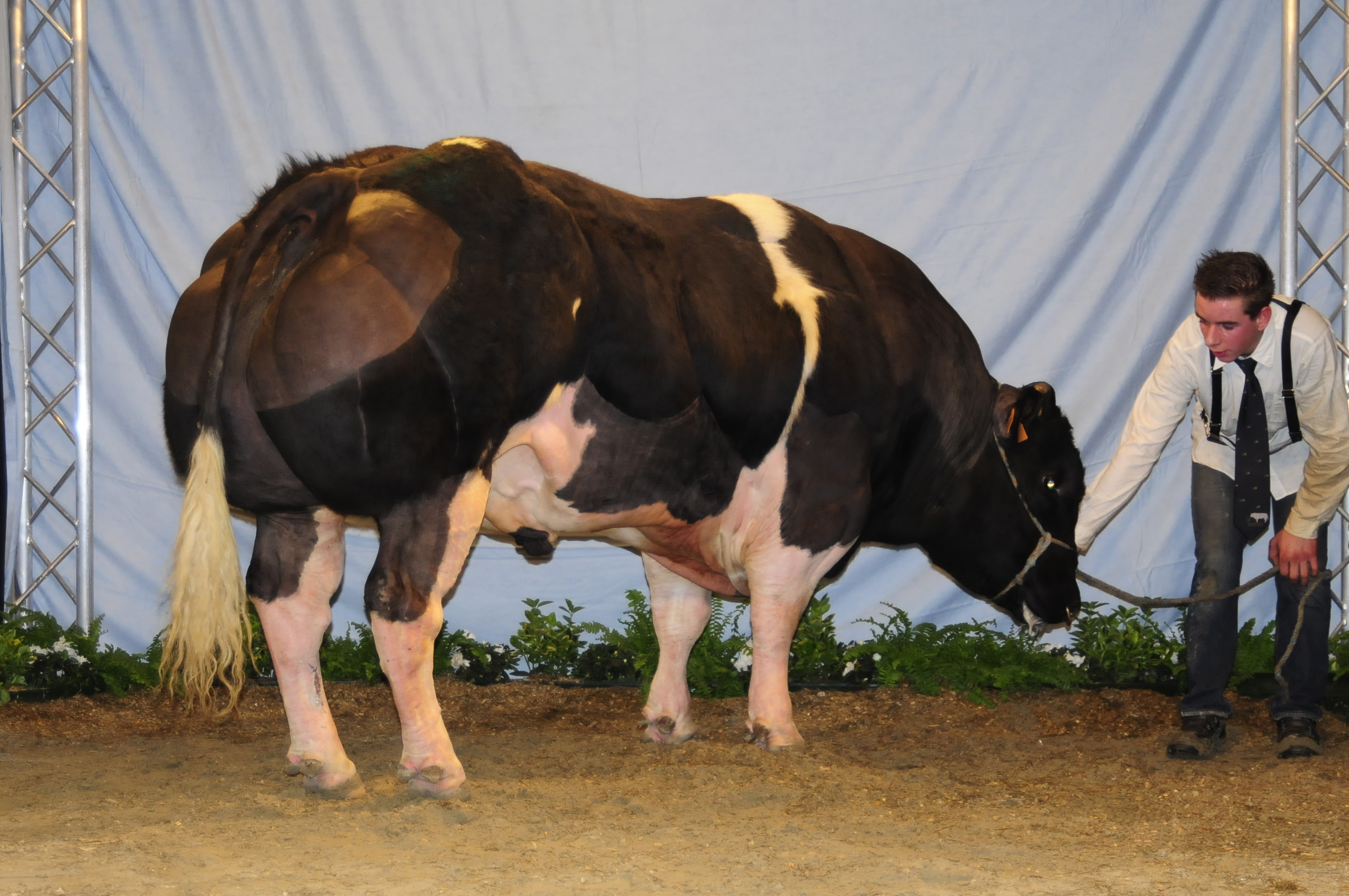|
Myostatin
Myostatin (also known as growth differentiation factor 8, abbreviated GDF8) is a protein that in humans is encoded by the ''MSTN'' gene. Myostatin is a myokine that is produced and released by myocytes and acts on muscle cells to inhibit muscle growth. Myostatin is a secreted growth differentiation factor that is a member of the TGF beta protein family. Myostatin is assembled and produced in skeletal muscle before it is released into the blood stream. Most of the data regarding the effects of myostatin comes from studies performed on mice. Animals either lacking myostatin or treated with substances that block the activity of myostatin have significantly more muscle mass. Furthermore, individuals who have mutations in both copies of the myostatin gene have significantly more muscle mass and are stronger than normal. There is hope that studies into myostatin may have therapeutic application in treating muscle wasting diseases such as muscular dystrophy. Discovery and sequenci ... [...More Info...] [...Related Items...] OR: [Wikipedia] [Google] [Baidu] |
MSTN Location
Myostatin (also known as growth differentiation factor 8, abbreviated GDF8) is a protein that in humans is encoded by the ''MSTN'' gene. Myostatin is a myokine that is produced and released by myocytes and acts on muscle cells to inhibit muscle growth. Myostatin is a secreted growth differentiation factor that is a member of the TGF beta protein family. Myostatin is assembled and produced in skeletal muscle before it is released into the blood stream. Most of the data regarding the effects of myostatin comes from studies performed on mice. Animals either lacking myostatin or treated with substances that block the activity of myostatin have significantly more muscle mass. Furthermore, individuals who have mutations in both copies of the myostatin gene have significantly more muscle mass and are stronger than normal. There is hope that studies into myostatin may have therapeutic application in treating muscle wasting diseases such as muscular dystrophy. Discovery and sequencing ... [...More Info...] [...Related Items...] OR: [Wikipedia] [Google] [Baidu] |
Activin Type 2 Receptors
The activin type 2 receptors belong to a larger TGF-beta receptor family and modulate signals for transforming growth factor beta ligands. These receptors are involved in a host of physiological processes including, growth, cell differentiation, homeostasis, osteogenesis, apoptosis and many other functions. There are two activin type two receptors: ACVR2A and ACVR2B. Despite the large amount of processes that these ligands regulate, they all operate through essentially the same pathway: A ligand binds to a type 2 receptor, which recruits and trans-phosphorylates a type I receptor. The type I receptor recruits a receptor regulated SMAD (R-SMAD) which it phosphorylates. The RSMAD then translocates to the nucleus where it functions as a transcription factor. Function Several ligands that signal through the activin type 2 receptors regulate muscle growth. Myostatin, a TGF-beta superfamily member, is a negative regulator of muscle growth. Myostatin binds to ACVR2B and to a lesse ... [...More Info...] [...Related Items...] OR: [Wikipedia] [Google] [Baidu] |
Whippet
The Whippet is a dog breed of medium size. It is a sighthound breed that originated in England, descended from the Greyhound. Whippets today still strongly resemble a smaller Greyhound. Part of the hound group, Whippets have relatively few health problems other than arrhythmia. Whippets also participate in dog sports such as lure coursing, agility, dock diving and flyball. The name is derived from an early 17th-century word, now obsolete, meaning "to move briskly". There has been continuity in describing Greyhound-types of different sizes: large, medium and small, recorded in hunting manuals and works on natural history from the Middle Ages. Edward of Norwich, 2nd Duke of York confirmed in his early 15th-century translation and additions to the original late 14th-century French '' Livre de chasse'' the advantage of maintaining the great, the middle, and the small size of greyhound for different sorts of game. The English physician and academic John Caius refers in his 16th ... [...More Info...] [...Related Items...] OR: [Wikipedia] [Google] [Baidu] |
Belgian Blue
The Belgian Blue (french: 'Blanc-Bleu Belge', nl, 'Belgisch Witblauw', both literally meaning "Belgian White-Blue") is a breed of beef cattle from Belgium. It may also be known as the , or nl, dikbil, label=none (literally "fat buttocks" in Dutch). Alternative names for this breed include Belgian Blue-White; Belgian White and Blue Pied; Belgian White Blue; Blue; and Blue Belgian. The Belgian Blue's extremely lean, hyper-sculpted, ultra-muscular physique is termed " double-muscling". The double-muscling phenotype is a heritable condition resulting in an increased number of muscle fibres (hyperplasia), instead of the (normal) enlargement of ''individual'' muscle fibres (hypertrophy). This particular trait is shared with another breed of cattle known as Piedmontese. Both of these breeds have an increased ability to convert feed into lean muscle, which causes these particular breeds' meat to have a reduced fat content and reduced tenderness. The Belgian Blue is named after ... [...More Info...] [...Related Items...] OR: [Wikipedia] [Google] [Baidu] |
Myokine
A myokine is one of several hundred cytokines or other small proteins (~5–20 kDa) and proteoglycan peptides that are produced and released by skeletal muscle cells (muscle fibers) in response to muscular contractions. They have autocrine, paracrine and/or endocrine effects; their systemic effects occur at picomolar concentrations. Receptors for myokines are found on muscle, fat, liver, pancreas, bone, heart, immune, and brain cells. The location of these receptors reflects the fact that myokines have multiple functions. Foremost, they are involved in exercise-associated metabolic changes, as well as in the metabolic changes following training adaptation. They also participate in tissue regeneration and repair, maintenance of healthy bodily functioning, immunomodulation; and cell signaling, expression and differentiation. History The definition and use of the term myokine first occurred in 2003. In 2008, the first myokine, myostatin, was identified. The gp130 receptor cytokine ... [...More Info...] [...Related Items...] OR: [Wikipedia] [Google] [Baidu] |
Muscle Hypertrophy
Muscle hypertrophy or muscle building involves a hypertrophy or increase in size of skeletal muscle through a growth in size of its component cells. Two factors contribute to hypertrophy: sarcoplasmic hypertrophy, which focuses more on increased muscle glycogen storage; and myofibrillar hypertrophy, which focuses more on increased myofibril size. It is the most major part of the bodybuilding-related activities. Hypertrophy stimulation A range of stimuli can increase the volume of muscle cells. These changes occur as an adaptive response that serves to increase the ability to generate force or resist fatigue in anaerobic conditions. Strength training Strength training (resistance training) causes neural and muscular adaptations which increase the capacity of an athlete to exert force through voluntary muscular contraction: After an initial period of neuro-muscular adaptation, the muscle tissue expands by creating sarcomeres (contractile elements) and increasing non-contrac ... [...More Info...] [...Related Items...] OR: [Wikipedia] [Google] [Baidu] |
Piedmontese (cattle)
thumbnail, A Piedmontese bull The Piedmontese ( it, Piemontese, italic=no or ) is a breed of domestic cattle that originated in the region of Piedmont, in north-west Italy. The calves are born fawn coloured, and turn grey-white as they mature. Piedmontese cattle carry a unique gene mutation identified as an inactive myostatin allele that causes hypertrophic muscle growth, or double muscling. Purebred Piedmontese cattle are homozygous, meaning they have two identical alleles present for this unique gene. They have garnered attention from breeders of beef cattle in other parts of the world, including North and South America. A small group of select Piedmontese bulls and cows were imported into Canada in the late 1970s, and into the United States in the early 1980s, and were used as the foundation breeding stock to develop a new breed of beef cattle known as North American Piedmontese cattle. History Until the late nineteenth century there were numerous local types of Pied ... [...More Info...] [...Related Items...] OR: [Wikipedia] [Google] [Baidu] |
Muscular Dystrophy
Muscular dystrophies (MD) are a genetically and clinically heterogeneous group of rare neuromuscular diseases that cause progressive weakness and breakdown of skeletal muscles over time. The disorders differ as to which muscles are primarily affected, the degree of weakness, how fast they worsen, and when symptoms begin. Some types are also associated with problems in other organs. Over 30 different disorders are classified as muscular dystrophies. Of those, Duchenne muscular dystrophy (DMD) accounts for approximately 50% of cases and affects males beginning around the age of four. Other relatively common muscular dystrophies include Becker muscular dystrophy, facioscapulohumeral muscular dystrophy, and myotonic dystrophy, whereas limb–girdle muscular dystrophy and congenital muscular dystrophy are themselves groups of several – usually ultrarare – genetic disorders. Muscular dystrophies are caused by mutations in genes, usually those involved in making muscle protei ... [...More Info...] [...Related Items...] OR: [Wikipedia] [Google] [Baidu] |
Transcription Factor
In molecular biology, a transcription factor (TF) (or sequence-specific DNA-binding factor) is a protein that controls the rate of transcription of genetic information from DNA to messenger RNA, by binding to a specific DNA sequence. The function of TFs is to regulate—turn on and off—genes in order to make sure that they are expressed in the desired cells at the right time and in the right amount throughout the life of the cell and the organism. Groups of TFs function in a coordinated fashion to direct cell division, cell growth, and cell death throughout life; cell migration and organization ( body plan) during embryonic development; and intermittently in response to signals from outside the cell, such as a hormone. There are up to 1600 TFs in the human genome. Transcription factors are members of the proteome as well as regulome. TFs work alone or with other proteins in a complex, by promoting (as an activator), or blocking (as a repressor) the recruitment of ... [...More Info...] [...Related Items...] OR: [Wikipedia] [Google] [Baidu] |
Gene
In biology, the word gene (from , ; "...Wilhelm Johannsen coined the word gene to describe the Mendelian units of heredity..." meaning ''generation'' or ''birth'' or ''gender'') can have several different meanings. The Mendelian gene is a basic unit of heredity and the molecular gene is a sequence of nucleotides in DNA that is transcribed to produce a functional RNA. There are two types of molecular genes: protein-coding genes and noncoding genes. During gene expression, the DNA is first copied into RNA. The RNA can be directly functional or be the intermediate template for a protein that performs a function. The transmission of genes to an organism's offspring is the basis of the inheritance of phenotypic traits. These genes make up different DNA sequences called genotypes. Genotypes along with environmental and developmental factors determine what the phenotypes will be. Most biological traits are under the influence of polygenes (many different genes) as well as ... [...More Info...] [...Related Items...] OR: [Wikipedia] [Google] [Baidu] |
Nucleotide
Nucleotides are organic molecules consisting of a nucleoside and a phosphate. They serve as monomeric units of the nucleic acid polymers – deoxyribonucleic acid (DNA) and ribonucleic acid (RNA), both of which are essential biomolecules within all life-forms on Earth. Nucleotides are obtained in the diet and are also synthesized from common nutrients by the liver. Nucleotides are composed of three subunit molecules: a nucleobase, a five-carbon sugar (ribose or deoxyribose), and a phosphate group consisting of one to three phosphates. The four nucleobases in DNA are guanine, adenine, cytosine and thymine; in RNA, uracil is used in place of thymine. Nucleotides also play a central role in metabolism at a fundamental, cellular level. They provide chemical energy—in the form of the nucleoside triphosphates, adenosine triphosphate (ATP), guanosine triphosphate (GTP), cytidine triphosphate (CTP) and uridine triphosphate (UTP)—throughout the cell for the many ... [...More Info...] [...Related Items...] OR: [Wikipedia] [Google] [Baidu] |






